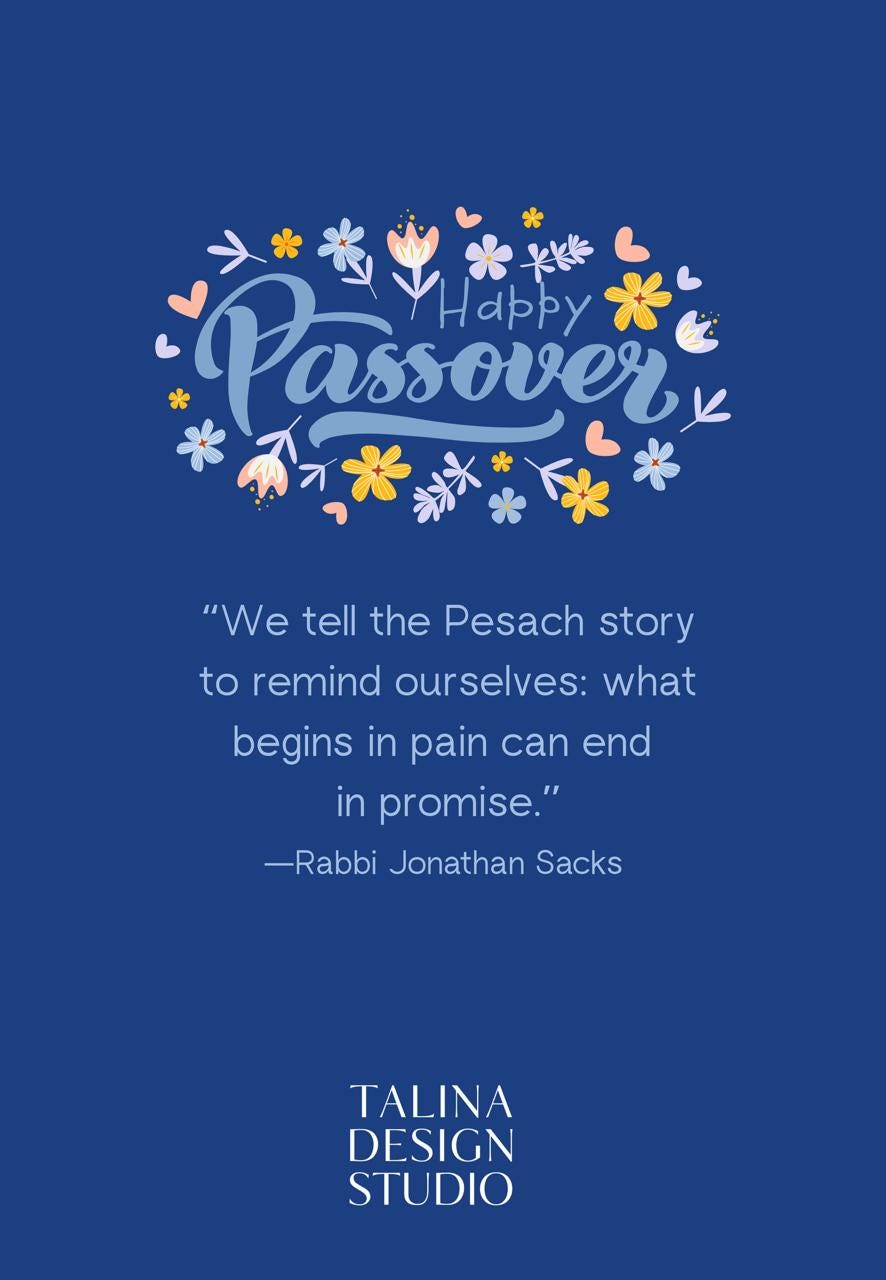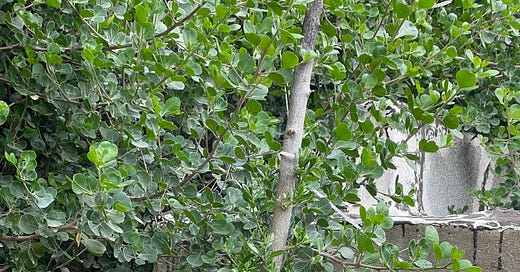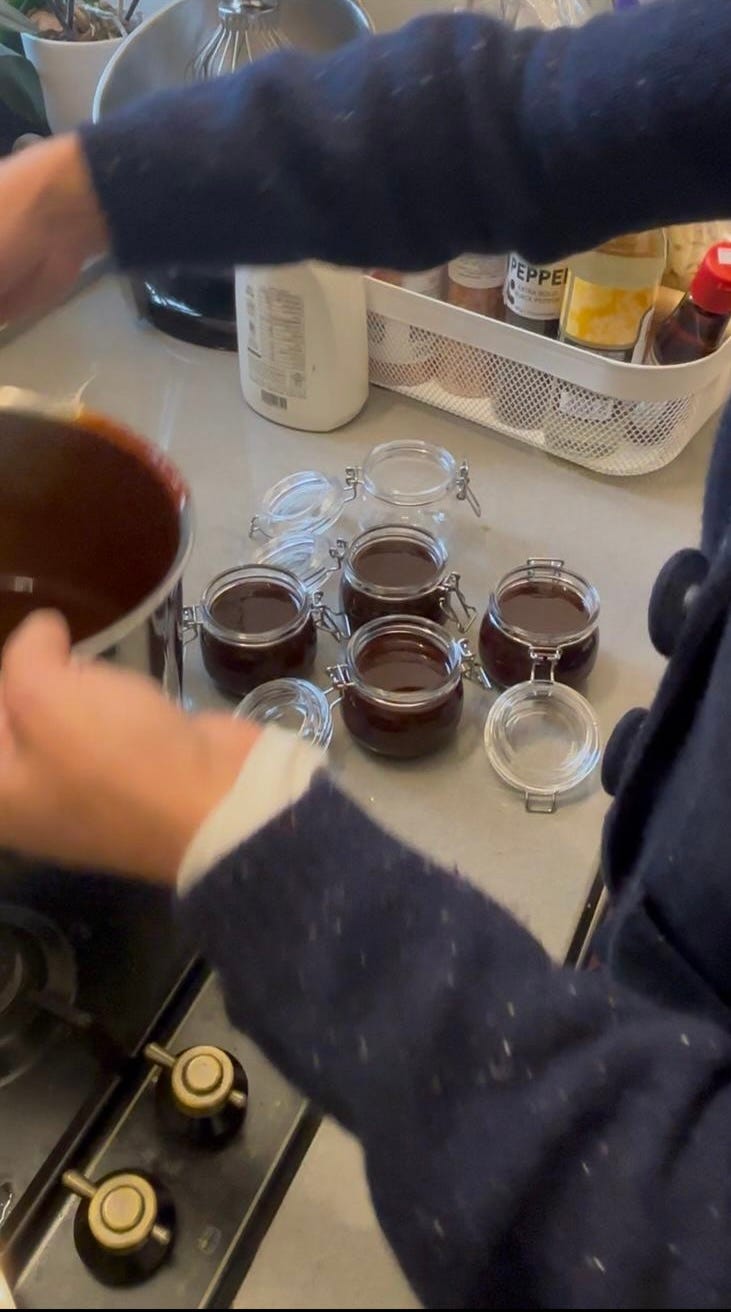Squeezing Sweet Sorrow - Making Date Syrup for Passover Seder
Hope is living in the unknown together. Entering the gap, sharing our stories, our pain and pleasure and holding them together. Plus Beautiful Poster, Poem & Date Syrup Recipe
In a world of volatile news and markets, loud slogans, so much despairing separateness, all I want is to tell you is about a young olive tree in my garden which I moved to a new spot a couple of years ago. Despite my loving watering and care it withered and dried up into brittle branches, remaining a slim trunk — Dead. The other day I watered my Spring tulips and noticed fresh green shoots sprouting from its trunk. Verdant leaves full of growth, full of hope — Alive.
My olive tree had not died, though many things have died. For many, it is hope.
We often look outside ourselves for the answers. All week I have been asking myself, how do people do this life? I ask my husband, “How do people live this life?” Like there is a secret to living that everyone else has and somehow I didn’t receive the memo. My husband says, they just live.
He is used to my strange questions.
The last year and a half has seen the loss of loved ones, loved friends, burned homes, extinguished love. There are small everyday pains and losses, like corrupt companies that don’t offer service for brand new ovens that explodes. At the same time there is my young olive tree blossoming. There is a son who does not come home for the festival. There is a son that comes home.
It is a festival of Passover this weekend. In preparation I have spent hours soaking, boiling, squeezing, and wringing medjool dates through a tea towel until I have a bowl of sweet brown juice to simmer until it becomes date honey. I have sore hands. I have a full heart. Hours well spent like my grandmother who knew deep grief and deep joy in her life.
There is a gap between suffering and joy. Reality and idealism. An olive tree with brittle branches and one that shoots shiny leaves. There is a gap where one gives up like I gave up on my olive tree. Panged that it wouldn’t grow because I had moved it. There is silence in this gap of acceptance of death. It is like a deep ocean. Dark but luminous towards the surface where the sun shines. Full of shadowed mysteries as we dip deeper.
There is a gap between my red raw hands and the date syrup I have produced to be used at our Passover seder table as charoset to symbolize the cement the Israelite slaves used to build pyramids for the pharaohs.
There is a gap between living in an ongoing war and relishing an olive tree that lives.
I cry into this gap.
I dream into it.
Last night I dreamt I was in a gathering of academics and intellectuals who commune to discuss peace, and at the end of the public section of the event they shoo away the mass of people from their dinner. As I leave I glare at them. I tell them they do not understand. One of the main women is offended and angry, follows me to tell me off. I tell her in my anger, “You don’t understand the suffering of the people. You don’t even want to understand.” I thought she would leave, return to her dinner, but she doesn’t. She remains. I ask her about her childhood. She tells me the story about her mother. I then tell her mine. I can barely speak, my voice is hoarse, it is too painful to speak about the displacement of Iraqi Jews. Yet, we share our stories and commune and bridge the gap by stepping into an ocean of human misery and mystery together. I wake up and am sorry it is a dream.
I live in this gap of silence.
I wake up and know I dreamed this because I am seeking hope. We manifest what we dream of.
I check my date syrup in the morning. It is more syrup than jam. I am relieved it is not over-boiled like last year.
This is the ritual of slave tears. This is the ritual of slave memory. Over 3400 years ago. How many grandmothers have squeezed their sorrow through muslin or tea towels, or in the refugee camps I am told for lack of anything, they used socks (clean ones I am sure). How many bitter herb meals have been shared through the generations from the times of the Israelites until now? In how many countries? How many meals did not need salt water to dip bitter herbs into because to be a Jew is to cry and wonder when the next persecution will come? What did Jesus taste at the Last Supper which was the Passover seder meal? (That’s why Easter is around the same time as Passover.)
I wanted to write about hope and yet here are the tears.
We eat the bitter herbs, romaine lettuce or horseradish (depending on your custom) with the charoset, the date honey sprinkled with crushed walnuts, in between two pieces of crispy Matzah. It is the Hillel sandwich. The sandwich of wisdom. How to hold both deep sadness and joy. How to live our life in between this gap of the unknown human condition and make a blessing. We do this together with family and community, from generation to generation.
We do not know what the future holds but we have a bitter and sweet sandwich to eat. We have each other.
Hope is living in the human mysterious ocean of life — together. Sharing our stories, our realities of pain and pleasure and holding them together. It is not always pretty. From the personal and petty (yes I get angry preparing for a festival and my boys do not help) to the national and heartbreaking (where are the hostages this Passover? How is it now our generation where Jewish persecution and erasure has risen up so boldly and blindly? How is it our children need to fight to protect us?)
Sometimes I want to break bread — without words, like my grandmother did. Enter the gap which causes us all pain. To chew into the silence and look into another person’s eyes. A stranger’s eyes (this is the festival of the stranger — we are reminded to never forget that we were strangers in a strange land). A family member’s eyes (why is family often our most trying test?). Yes it’s very uncomfortable to enter the unknown, the gap, the mystery of what could be. But perhaps it’s an alternative for humanity. I cannot stop the ideological extremists, but I can engage with every human being who is open to entering this messy gap, breaking bread, sharing their story and believing in each other, which may take the form of olive leaves, the earth’s message of hope and renewal through a young olive tree I had given up on.
How do we do life? We don’t do life, a quiet voice replies. We serve life. Entering the gap is serving life.
Wishing you all no matter what your background a time of living in the space of festival, a time to open up in joy and humanness, a time to hold grief and loss and vulnerability. A time to strengthen belief and hope together.
And yes wishing you all a Jewish Passover celebration of holding both joy and grief, our ancient traditions and history and wisdom.
With blessings,
Sarah
Below is a beautiful poster, poem and my date syrup Halek recipe for anyone crazy enough to ask for grief — the syrup is delicious, and I don’t care what my cousin says no store bought jar, even if it’s organic, tastes as good.

POEM
Why is this Night Different
because this evening I burnt the dates
charred like my grandmother’s heart
I attempt another batch
break open plump Medjools
pry open pips
boil until squashy
enough to squeeze
the living daylights out
into dark dripping syrup
meant for dipping
bitter herbs
my grandmother squeezed
regrets and rough journeys
through white muslin
clenched in olive oil fists
until the dates wrung dry
and honey spurted forth sweet
I clasp the same cloth
mine is stained with birth blood
what I mean is that I swaddled
my sons and made covenants
in four by four squares
to wrap their circumcisions
to hold and heal
all that needs holding
why do you work so hard
my cousin asks
to remember my grandmother
so my children remember me
First Published in Lilith Magazine
Iraqi Halek - Silan - Date Syrup for Charoset - Sarah Sassoon
This is a recipe my grandmother gave me over the phone when newly married and living in Johannesburg I called to ask how to make the sweet, deep date syrup I remembered from my grandparents’ seder table. It involves soaking, boiling and squeezing the dates through muslin, and then boiling again. It’s a long process which marks my hands with red blisters. Many people these days just boil the dates and blend, but the blisters are worth it for the true, authentic taste which reminds me of how hard the Israelite slaves worked to churn out the brown building mud that charoset symbolizes, but more than that it reminds me of the rich Babylonian Jewish culture I come from, and my grandmother’s love that she squeezed and poured into wine bottles full of date syrup that she gifted us every Pesach.
Recipe
Ingredients
1 kg Dates (notably you can make more, but it’s a lot of work.)
Water
Muslin
Method
Rinse and soak 1 kg of pitted dates for three hours with water just covering two fingers above. Bring the dates to the boil and simmer for five minutes, or until soft. Once cooled take batches of about one cup of dates and squeeze into date juice through the muslin into a bowl or pot. Boil the squeezed juice in a pot and simmer on low heat for two hours, be very careful not to burn, or until a thick syrup consistency. Once cool store in a glass jar. It keeps for a long time, growing richer and deeper like wine.
Iraqi Jewish Passover Seder Article - For a wonderful overview of Iraqi Jewish Passover customs read Elana Benjamin’s article in The Jewish Independent here.
For more about me and my writing visit my website www.sarahsassoon.com
To support my work please consider buying my children’s books, the award winning Shoham’s Bangle, and my latest This is Not a Cholent. My mission is to spread and educate about Jewish Middle Eastern culture.
Read my free online, award winning poetry collection, published by Harbor Review - This is Why We Don’t Look Back.
Note - My Substack will be fortnightly. Maybe more often… I appreciate all comments, all conversations, and all sharing.
Further - All mistakes are proof that I am human, and this is not an AI publication.









חג פסח שמח